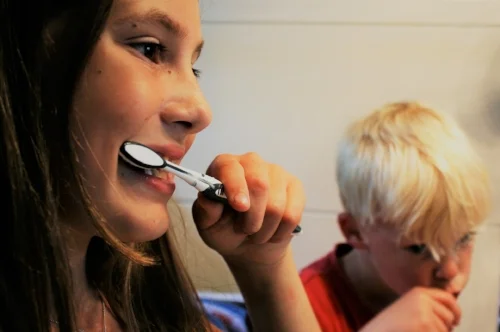Mornings are the worst! You need to get yourself, your spouse, and your kids out the door dressed, fed, and ready to take on the world. It's a monumental task.
The best way to streamline this process is to create a morning routine. The following tips will help you to create a morning routine that works for your family.
On the one hand, I could give you my morning routine, but I don’t think that would be very useful unless you have the exact same life as me. Unless you have a kindergartener, a toddler, and a breastfeeding baby, you probably don’t have to do the same things.
Instead these tips will give you things to consider to create a routine that will work for you and your family.
This time of year when everything gets hectic, its helpful to have a routine to keep us grounded and sane. These tips will help you do just that.
Recognize the Nature of Your Family Members
Some people are morning people, others are night people. I am a morning person; I wake up refreshed and ready to start the day. My husband is a night person; he would prefer to wake up later and is often groggy in the morning.
In order to have the least amount of frustrations in the morning, it is important to take these tendencies into account.
It may seem unfair or unbalanced, but the morning person, if there is one, should take on most, if not all of the morning prep. The other person barely has enough wherewithal to get themselves dressed and ready. Expecting too much more will just lead to anger and frustration.
The same goes for the kids. If one kid generally rises earlier than the other, then that's the order you should help them get ready. Granted, the kids may not want to get ready at all, but working with their nature as much as possible can help.
Be Specific
When looking at everything that needs to be done before you can head out the door, be very specific about the tasks. Don't just list get Tyler ready, get Hailey ready, specify what you have to do. Write: get Tyler dressed, comb Tyler's hair, brush Tyler's teeth, give Tyler vitamins, etc.
This will help you in 2 ways. First it will allow you to determine what your child can do for themselves and what you need to help them with. Second it helps you getting a better idea of how long helping your child will take.
You should take this into account when determining how long you need to get ready to go in the morning. If helping Tyler takes 20 minutes in the morning, you need to take that into account both as far as how much time he needs to get ready and how much that adds to your to dos as well.
Assign Tasks
Once you know all that tasks that need to get done, everything should be assigned to at least one person. For example, getting yourself dressed and made up will probably be assigned to you. Getting your child dressed could be assigned to just your child or both you and your child depending on their age.
Everything that needs to get done should be assigned. Much of our stress in the morning comes from wasting time trying to remember what needs to get done or figuring out who should do it. If everyone knows their roles in advance, this saves a lot of trouble.
Use the Evening Before for Prep
Remember when we talked about who was a night person and who was a morning person? Here is a way for the person with morning duty to even the score.
If you have morning duty, let the other person do the night prep. This can include things like making sure the coffee maker is prepped, making sure school bags are packed and by the door, and making sure the kids clothes are ready for the morning.
A little bit of prep the night before can go a long way in the morning. Do not underestimate the power of pre-selecting everyone's outfits the night before. Other things that can be done the night before include making lunches, creating the next day's to do list, and making sure your work bag is packed.
Include Buffer Time
Even with the best laid plans, things happen. The coffee gets spilled, the baby throws up, the toast gets burnt. Its important to build in some buffer time into your plan. This can be done in two ways.
The first way is to slightly over estimate the time it takes to complete each task so that you end up with some extra time built in. I personally prefer this method because if your first tasks go as planned you will be ahead of schedule and that always feels awesome. The other option is to just add an extra 10 minutes to the end of your schedule so you can compensate for life's little surprises.
Either one of these can work well to ensure you have enough time to get out the door unhassled each morning.
If you need more guidance on creating your morning routine, check out my Manage Your Mornings Workbook which shows you all the steps for creating a morning routine that works for your family.
Need additional guidance or want to see it put into practice? Take my Manage Your Mornings Course (coming soon)! It will walk you through the steps of creating a morning schedule for every member of the family.
Cheers,
Emily









